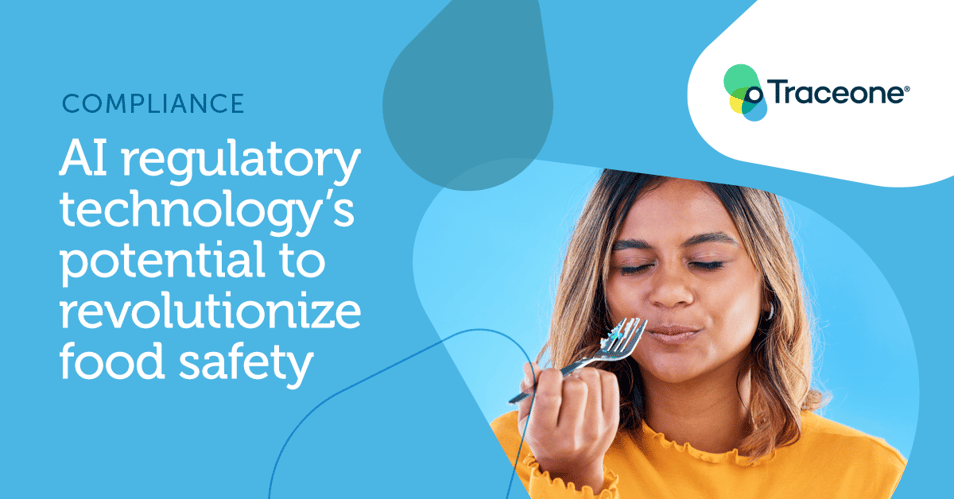
AI regulatory technology’s potential to revolutionize food safety
|
Regulatory
Posted By:
Erika Redaelli
One of the hottest topics in business and technology is Artificial Intelligence (AI), especially generative AI, and how it is revolutionizing digital processes and products. But in the physical world of food manufacturing and retailing, what use can AI offer?
Well, it turns out that AI’s ability to handle large and complex data streams, automate processes, distill meaning from information sources, and create baseline content for human enhancement are all abilities perfectly suited to tackling the ever more complex world of food safety.
But where are we now?
We have to go back to look forward to AI “locking in” food safety. Let’s deconstruct the challenges we all have with maintaining and ensuring food safety:
- Systems are vulnerable in a global supply chain because it’s difficult to maintain quality across geographies. If you were in this business during the ethylene oxide crisis of 2020-2021, we don’t need to tell you how the globalized supply chain broke down.
- New food production technologies can introduce new risks to public health from foodborne disease. A recent example is the use of animal-based serum in cell-based meat culture that could introduce microbiological and chemical contamination.
- Climate change, pollution, and natural disasters are creating new impacts on food safety. For example, climate change has been shown to alter the virulence, occurrence and distribution of certain biological and chemical contaminants in food.
- New pathogens that can cause foodborne illness are being continuously monitored to stay ahead of potential outbreaks.
Now for the AI excitement
AI can ingest food safety information much faster than an office full of quality control employees. Training AI on databases of regulatory information could provide more accurate and helpful recommendations and highlight novel issues and potential solutions.
It doesn’t stop with regulatory libraries. Many businesses have an amazing asset in their internal product and customer data. AI’s predictive capabilities can be unleashed to make predictive suggestions through analyzing this unique content. This can help with increasing market share for products, taking advantage of trends, and cutting costs in formulations while ensuring food safety.
But what about the errors?
If you’ve spent any time trying to get the free AI tools to answer regulatory questions, you’ll understand why we started out skeptical. For example, I tried to ask about regulatory controls covering the allowable amount of lead in potatoes. I received a whole spectrum of answers, ranging from nonsense to amazing insight, because AI is not able to discriminate which source is reliable and which one is junk.
At Trace One, we’re working on developing AI tools in our solutions that deliver real answers you can use. (The answer is, and the kind of answer we hope will come up in your AI-enabled Trace One search, if we do our job right: According to Regulation 915/2023/EC, the limit for lead on root and tuber vegetables is 0.10 mg/kg, applied to the wet weight, after washing and separating the edible part. For potatoes, it applies to the peeled vegetable.)
Coming soon for AI regulatory compliance
Here are areas where we’re exploring artificial intelligence integration with regulatory and product life cycle management software:
- Regulatory libraries and classification. Trace One Regulatory Compliance draws information from a network of reliable sites with pertinent news and regulations, like food safety, alert, and legislative changes. AI can be a powerful helper in capturing regulatory resources, scanning thousands of relevant documents and classify them to make it easier for our users to search for information.
- Simpler product queries. Our customers already use REGDATA®, our regulatory substance limits database covering additives, contaminants, pesticides and veterinary drugs. AI has the potential to help users create simpler queries and use more conversational interfaces to get relevant information faster from REGDATA and other Trace One databases.
AI also has the potential to work with customer databases in a PLM to include data on current, historic and extended supply chain information. “Which of my products are at risk of globally exceeding limits for lead”? would be a good example of using internal data and regulatory data to answer your questions.
3. Better documents – translations, and more. AI can help you understand regulations in other languages without first translating the entire document. AI also can summarize and extract information to create short abstracts from labyrinthine regulatory documents. Supply chain documentation and data will only continue to grow, and effective professionals will use AI as an ally to keep ahead of changes.
We’re excited by the potential for AI support in food safety regulation and look forward to rolling out powerful new AI-powered features to our suite of product lifecycle management products. Your experience as a regulatory professional is crucial to us—please reach out with any ideas you may have for how AI can help you address food safety challenges. Or book a demo to see where we are today and how you can safeguard your food safety future with us.
